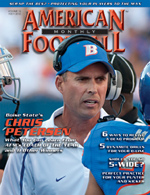AMERICAN FOOTBALL MONTHLY THE #1 RESOURCE FOR FOOTBALL COACHES
|
|
Article Categories
|
The 5-Wide Attack Spread Offense© More from this issueOffense is such a personal choice. The type of offense you run really reflects your personality. No one can tell you that one offense is better than the other. It is a personal preference. Yet you need to understand different types of offenses: I, Wishbone, Wing-T, Single Wing, Spread, etc. There are also different styles of offense: time consuming, no-huddle, power running, option, etc. You have to determine what best suits your style or personnel.
For two out of three years we were 5-0 and playing our district rival for the district championship. They were one of the best teams in the state with one state title and another state runner-up on their resume in a four-year period. We lost the first time we played them. However, with a running back who had 1,800 yards and 23 touchdowns and four linemen who went on to play FBS f....The full article can only be seen by subscribers.
Subscribe today!

|
|
|
NOT A SUBSCRIBER?
Subscribe
now to start receiving our monthly magazine PLUS get INSTANT
unlimited access to over 4000 pages of 100 percent football coaching
information, ONLY available at AmericanFootballMonthly.com!
|
|
|
HOME
|
MAGAZINE
|
SUBSCRIBE
|
ONLINE COLUMNISTS
|
COACHING VIDEOS
|
Copyright 2025, AmericanFootballMonthly.com
All Rights Reserved






